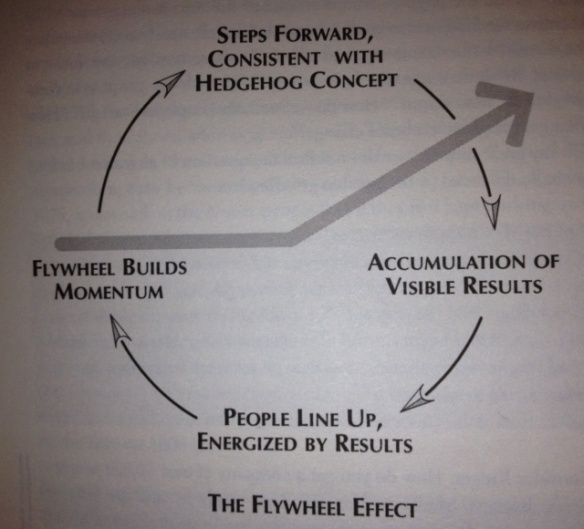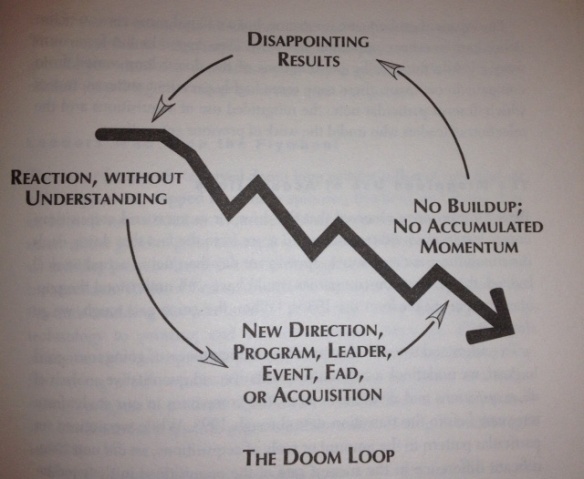I woke up at 0100 last night, thinking about work. This is rare. One of the more challenging aspects of my new role is establishing the facts about how it all works, so we can confront and deal with them. “I need facts!”, I thought, as my mind raced and the LED clock seemingly stopped.
I remembered how important the confrontation of facts is in Good to Great by Jim Collins. I reckoned at 0100 that facts must be the most important bit, the idea that trumps all the others.
Then I remembered I’d clumsily summarised the book last year. I decided to read the summary in the morning to prove myself right, and got myself back to sleep by imagining I was Geoff Boycott batting in a test match. It works every time…
I woke five hours later to find I was wrong, the whole book is brilliant. Here is my clunky summary. The book is made all the better by each chapter having a one page summary from which I extracted the bits I agreed with and ignored the bits I didn’t, or which I simply didn’t understand:
1 Level 5 Leaders
- Humility, low ego and high will
- Set up successors for success
- Diligent, work horses
- Credit to others for success, blame themselves for failings, think their success is luck
- Lack of celebrity status
- Get the right people on the bus first
- The “genius with followers” model fails when the genius departs
- Little reliance on lay offs (got it right in the first place)
- Right people in each role
- Vigorous debate common place
- The right people are your greatest asset (not just people)
- Create a culture in which people can be heard by
-
- Asking questions not giving answers
- Engaging in dialogue and debate not coercion
- Conducting autopsies without blame
- Build red flag mechanisms that turn information into information that cannot be ignored
- Retain faith and you will prevail AND confront the facts. Need to to both.
- It’s equally as important as the vision
- Dealing with the facts is central to motivating people
- Understand three circles to define your hedgehog
-
- What are you deeply passionate about
- What can you be best in the world at
- What drives your economic engine
- The concept is not a goal or strategy, it is an understanding
- What you can be best at might not be your core business, it might even be a competence you currently don’t have
- For economic engine, seek out a unifying metric,
- It’s iterative, be information rather than bravado driven
- It takes years to work out the simple set of factors that make your HC
- Fanatical discipline within the circles
- Bureaucracy rises to overcome incompetence and a lack of discipline. Mostly the result of having the wrong people in the first place.
- Duality: adhere to system but freedom to act within the framework of that system
- Disciplined people, thought and action
- Avoid bandwagons
- Select carefully
- Does it fit the HC? If so then pioneer. If not then you can ignore or settle for standard.
- It’s an accelerator of momentum not the basis of it
- Employ technology for outcomes not as an end in itself or out of fear of being left behind
- Not cited as the top five factors in change by 80% of successful companies
- Crawl, walk, run…
- They look dramatic from the outside, it is attritional in reality
- There is no transformational programme or event
- Consistent build up and break through reign, it’s a flywheel
- Those that fail, skip build up and seek quick breakthrough, then fall back on a set back
- Failures use acquisitions to break through, successes consolidate break through with acquisition
- Successes tend only to notice their success after the fact, there was no event, no programme
- Great leaders spent no time explicitly creating alignment, motivating or managing change. These follow results, they are not precursors.
- The short term pressures of Wall Street aren’t consistent with this model.
It is a great book. That is a fact.




Have not read ‘Good to Great’ but on the basis of your summary I’ll now be adding it to my reading list–as long as it does not cause me to wake up at one in the morning thinking about facts!
Speaking of which, there is something here, in this, about the relationship between facts and actions. I can’t quite formulate exactly what it might be but I think it’s something along the lines of the fact (pun intended) that facts often initiate actions but that they are not sufficient in themselves to inform the outcome of the actions we take. And this is why plans (a collection of facts) do not always result in the outcomes (result of taking actions on the basis of those facts) that we expect them to have. In fact, you can only ever be sure of finding out what those outcomes are by acting and not just thinking about it. Something like that.
Probably a little too simplistic so I’ll just let you think about it, then act on it by writing another blog posting so we can see what the outcome is!
Thanks, Anthony.
Ian
Thanks also for joining in. I will repeat the thanks I sent to Andrew. The conversation is important. Being challenged is enriching. I usually buy those who do it beer.
The point in the book is actually less about facts themselves as about coldly recognising them, confronting them and acting on them.
I make an observation in my work very often that we defer pain. I think we hope that if hold out, the pain will land on someone else’s desk. This is very typical when looking at project risks. We hunker down, certain that Technology will be late and that our operational tardiness wont be discovered.
I saw this once at Orange about ten years ago. We did total refresh of the PAYG proposition. Customer Services were not geared up for it but declared themselves on track, week after week. Their assumption was that Technology would fail and buy them time.
There was an amazing board meeting when with two weeks to go to launch Technology declared they were ready and on time. I had never actually seen the blood drain out of someone’s face. But it did when the CEO turned to the Head of CS and said. “And you’re ready too right?”.
The thing about facing facts is that the ultimate pain of doing so is low but now. The pain of doing so later is excruciating but high.
As far as I can tell corporations routinely elect to have a tooth extracted tomorrow without anaesthetic over a relatively painless drill and fill today.
As to the point you actually made I will have to think about it 🙂
Anthony
I’ve not read ‘Good to Great’ either but from your impromptu book review I’m not convinced I want to. Here’s why.
1. Level 5 Leaders. I think this is put together by someone who clearly went to school in the Billy Bunter era where the local bobby would give you a clip round t’ear for scrumping from the Vicar’s orchard. He clearly has never sat in a room with highly effective CEOs. Don’t get me wrong, many of the virtues you describe are laudable but must be placed in balance with a dose of pragmatism, tough decision-making, and at times a cold and calculating nature. Are you seriously saying that Richard Branson has a low ego ? Or Lord Sugar ? Or Anita Roddick ? Nobody could deny their not effective leaders give the successes of their organisations.
2. Who then What. Completely agree with this. Unfortunately, it is probably the single hardest thing to get right, and keep right, in an organisation.
3. Confront the facts. Facts are a good place to start, but often not where you end up. Innovation is one of the hardest things to implement as a cultural change in any organisation since in order to do it, you have to accept that you are allowed to proceed without all the facts. You can’t define and ROI (always) when you innovate. I was asked recently how I made the business case for Jive. Short answer: I didn’t, nor did I feel I had to. How do you quantify or monetise improved collaboration ? I’ve heard Jive themselves attempt this and it just looks like a 7 year-old attempting calculus. So did I have all the facts when I implemented ? No. Has it been an unmitigated success ? Yes.
4. Hedgehog Concept. Can you translate that from management techni-babbilo for me ? I munged it for a while but still got no closer. I did run it through Google Translate and it made marginally more sense in Norwegian, save for the reference to milk which I’m sure was wrong.
5. Culture of Discipline. I’m all for discipline, as long as it is pointed in the right direction. If discipline means over-reliance on someone else’s rules, you’re stuffed. I had this discussion recently with someone about innovation and said that one of the critical success factors for anyone working in that area is that they have to be comfortable with a lack of structure. Many people mistake that for being able to do what the hell they want when it is actually quite the reverse. You have to be willing to put your own operating frameworks around you and your work almost in real time so things are focused, accurate and well executed. In many respects you need to be even more disciplined than if someone puts some crappy project management methodology in there since everyone thinks their being all disciplined by sticking to it when actually they’re doing the exact opposite.
6. Technology accelerators. Now you’re talking. I hear this time and time again. “Implement this solution and it will be the end of world famine, provide the cure for cancer and will rid the world of Bieber.” Technology is like the petrol in a car, it isn’t the car itself. It’s needed to make the car work but you still need a car, and you still need a driver, and you still need somewhere to go with a purpose. Collaboration tools are a brilliant example. “Implement Jive and everyone will collaborate !!!”. Wrong. Acknowledge that people are already collaborating in an inefficient way AND acknowledge that you have a culture willing to try something new AND acknowledge that it won’t be perfect on day one AND acknowledge that there will be an adoption curve which will push it in a direction you probably didn’t expect and THEN it will work. Implement ‘enterprise collaboration’ in an all-company-you-will-collaborate-at-3pm-on-a-Tuesday-or-else way and you’re doomed. You’ll end up with a funky intranet. Wait. That sounds familiar.
Your diagrams. I tried using these to get through Level 17 on Tomb Raider but maybe that’s not what they were intended for.
Clearly not enough facts, or I’ve become a milky hedgehog.
Andrew
As ever a useful, insightful and amusing response. We have discussed this a few times, but I will say it here for the record. I like being challenged, it is part of the point of all this. I find a lot of the discourse on blogs a little safe. I write about things I am thinking about, often quite deeply. Equally they are usually things I am unsure of. Writing it down helps my understanding. The discussion that follows helps even more.
The, “Where I am, what I am doing and who I am with”, series was a case in point. I had been wrestling to balance the immense power of social collaboration for a while. In the end I concluded that understanding my purpose was the key bit. Now and again I do want to say, “Look at me!!!”, why not! J
Anyway, having flunked the Level 5 Leadership test so royally, on to some specifics on your comment here:
I failed in my summary to give a flavour of the method in the book. The basis is a numerical analysis of companies that have been most successful over an extended period.
The book then seeks to work out what these companies, many of which I had never heard of, have in common. Of course, not all companies had all characteristics. The book seeks to distil the typical features of such companies.
For example, some did have charismatic leaders, but the great majority not.
The test isn’t whether a company can succeed with a charismatic leader, they clearly can. It is whether success is sustained when they leave, or die.
What will happen to Amstrad when Sugar goes?
What is the trajectory of innovation at Apple, not to mention the stock price?
How well did Gates manage succession? I think rather well.
How many leaders can we point at who damaged companies with trophy acquisitions and ego driven mega projects? I haven’t got time. HP springs to mind.
As for facing facts, that is more about facing them and dealing with them coldly, than quantifying them. Some facts are quantified, others observed, inferred or asserted. One of the facets of good management is the ability to take risk calls based on partial information.
This characteristic of successful companies does not imply decision making only driven by data, but a behaviour of saying things like, “The market for x is dying. Lets get out of it now.”. Of course you could quantify that example. The point though is to confront the fact and deal with it in you own terms and in your own time, rather than a hasty retreat when its too late, with painful lay offs etc etc. I have a blog behind the firewall called, “Mistakes we knew we were making”, they drive me absolutely nuts and we do it all the time.
The hedgehog concept one I struggle with a little too. It is I think about focus and the avoidance of ego trips. It ties back to the Level 5 Leader point. Focussing on a few simple things what we are really good at and which work, over and over again is I think effective. One of the L5 Leader points is about the suppression of ego. Where this one may fall down is when your market gets disrupted. Then you’d better be pretty good at confronting the brutal facts.
I am blessed by being only dimly aware of who Mr Beiber is. I expect he has a digital watch and, doubtless, an automatic video recorder.
Thanks again,
Anthony
Perhaps you should read the book before spending time writing your thoughts about it. Good to Great is actually a 5 year research project that has been condensed incredibly well into one of the best business books ever written.
The Level 5 leader stuff is one of the best parts to emerge from the research. And no, Anthony is not suggesting that Branson, Sugar and Roddick are egoless, they are simply not level 5 leaders. They are level 4 or below. In Sugars case, he’s probably a level 1.
Collins spent a considerable amount of time during that 5 years with the CEO’s, execs and employees of the most successful – in terms of sustained performance over the long haul (15+ years minimum) – organisations out there and his results are compelling reading.
Thats not to say that there are not ‘good’ companies or ‘good’ leaders out there. There are, they make up the majority. The problem, as Collins points out, is that they are not ‘great’. In his words, “good is the enemy of great.”
Apologies for at least 2 grammar errors and 1 typo above. I’m obviously not disciplined enough on my spell-checking.
@anthony Gates didn’t handle succession well – he put that dickhead Ballmer in charge.